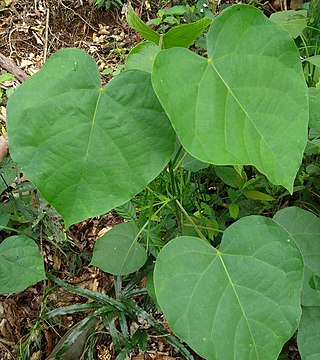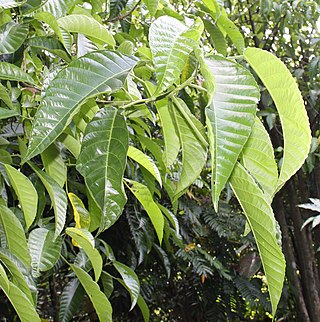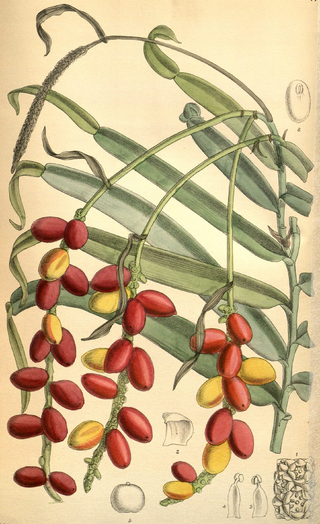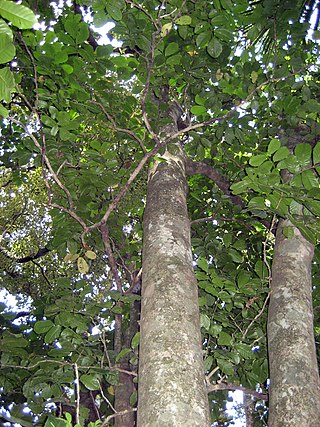
Antidesma is a genus of tropical plant in the family Phyllanthaceae formally described by Linnaeus in 1753. It is native to tropical Africa, S + E + SE Asia, Australia, and various oceanic islands. The greatest diversity occurs in Southeast Asia.

Claoxylon is a flowering plant genus in the spurge family, Euphorbiaceae, comprising dioecious subshrubs to small trees. It was first described as a genus in 1824. The genus is distributed in paleotropical areas: Madagascar through South and Southeast Asia, Malesia to Melanesia, Hawaiʻi, and Australia. Half of the species are in Malesia. According to a molecular phylogenetic study by Wurdack, Hoffmann & Chase (2005), Claoxylon is sister to Erythrococca, and together they form the top of a Hennigian comb-like phylogeny.

Melanolepis is a plant genus of the family Euphorbiaceae, first described as a genus in 1856. It is native to Southeast Asia, New Guinea, and some islands of the western Pacific.
- Melanolepis multiglandulosa(Reinw. ex Blume) Rchb. & Zoll - Nansei-shoto, Mariana Islands, Solomon Islands, Bismarck Archipelago, New Guinea, Maluku, Sulawesi, Philippines, Lesser Sunda Islands, Java, Sumatra, Borneo, Thailand, Malaysia, Taiwan
- Melanolepis vitifolia(Kuntze) Gagnep. - Vietnam, Cambodia

Endospermum is a genus of plants, under the family Euphorbiaceae and the monotypic subtribe Endosperminae first described as a genus in 1861 They are dioecious, rarely monoecious trees. It is native to E + S + SE Asia, Papuasia, Queensland, and certain islands of the W Pacific.

Codiaeum is a genus of plants under the family Euphorbiaceae first described as a genus in 1824. It is native to insular Southeast Asia, northern Australia and Papuasia.

Breynia is a genus in the flowering plant family Phyllanthaceae, first described in 1776. It is native to Southeast Asia, China, Réunion, the Indian Subcontinent, Papuasia and Australia.

Dendrocnide is a genus of approximately 40 species of plants in the nettle family Urticaceae. They have a wide distribution across North East India, Southeast Asia, Australia and the Pacific Islands. In Australia they are commonly known as stinging trees.

Pothos is a genus of flowering plants in the family Araceae. It is native to China, the Indian Subcontinent, Australia, New Guinea, Southeast Asia, and various islands of the Pacific and Indian Oceans.

Melodinus is a genus of plant in the family Apocynaceae, first described as a genus in 1776. It is native to Indomalaya, Meganesia and various islands in the western Pacific. A type of monoterpenoid indole alkaloids called melodinines can be isolated from Melodinus plants.

Ochrosia is a genus of flowering plants, first described in 1789. It is in the family Apocynaceae, native to Southeast Asia, Australia, and various islands of the Indian and Pacific Oceans.
- Ochrosia ackeringae(Teijsm. & Binn.) Miq. – Indonesia, Philippines, Papuasia, Christmas Island
- Ochrosia acuminataTrimen ex Valeton – Sulawesi
- Ochrosia alyxioidesGuillaumin – Vanuatu
- Ochrosia apoensisElmer – Luzon, Mindanao
- Ochrosia balansae(Guillaumin) Baill. ex Guillaumin – New Caledonia
- Ochrosia basistaminaHendrian – Sulawesi
- Ochrosia bodenheimarumGuillaumin – Vallée de la Toutouta in New Caledonia
- Ochrosia borbonicaJ.F.Gmel. – Mauritius + Réunion; naturalized in Guangdong
- Ochrosia brevitubaBoiteau – New Caledonia
- Ochrosia brownii(Fosberg & Sachet) Lorence & Butaud – Nuku Hiva in Marquesas
- Ochrosia citrodoraK.Schum. & Lauterb. – New Guinea
- Ochrosia coccinea(Teijsm. & Binn.) Miq. – Maluku, Sulawesi, New Guinea, Solomon Islands; naturalized in Guangdong
- Ochrosia comptaK.Schum., Hōlei – Hawaii
- Ochrosia ellipticaLabill. – Lord Howe Island, Queensland, New Caledonia, Vanuatu, Nauru; naturalized in Guangdong + Taiwan
- Ochrosia fatuhivensisFosberg & Sachet – Fatu Hiva in Marquesas but extinct
- Ochrosia ficifolia(S.Moore) Markgr. – New Guinea
- Ochrosia glomerata(Blume) F.Muell. – Borneo, Sulawesi, Philippines, Maluku, New Guinea, Solomon Islands
- Ochrosia grandifloraBoit. – New Caledonia
- Ochrosia haleakalaeH.St.John, Hōlei – Maui + island of Hawaiʻi in Hawaiian Islands
- Ochrosia hexandraKoidz. – Kazan-retto
- Ochrosia inventorumL.Allorge – New Caledonia
- Ochrosia iwasakiana(Koidz.) Koidz. ex Masam.
- Ochrosia kauaiensisH.St.John, Hōlei – Kauaʻi in Hawaiian Islands
- †Ochrosia kilaueaensisH.St.John, Hōlei – island of Hawaiʻi in Hawaiian Islands, but extinct
- Ochrosia kilneriF.Muell. – Queensland
- Ochrosia lifuanaGuillaumin – Loyalty Islands + Isle of Pines in New Caledonia
- Ochrosia mariannensisA.DC. – Mariana Islands
- Ochrosia mianaBaill. ex Guillaumin – New Caledonia
- Ochrosia minima(Markgr.) Fosberg & Boiteau – Queensland, Papua New Guinea
- Ochrosia moorei(F.Muell.) F.Muell. ex Benth. – Queensland, New South Wales
- Ochrosia mulsantiiMontrouz. – New Caledonia
- Ochrosia nakaiana(Koidz.) Koidz. ex H.Hara – Ogasawara-shoto
- Ochrosia newellianaF.M.Bailey – Queensland
- Ochrosia novocaledonicaDäniker – New Caledonia
- Ochrosia oppositifolia(Lam.) K.Schum. – Seychelles, Chagos Islands, Sri Lanka, Maldive Islands, Andaman & Nicobar Islands, Thailand, Vietnam, W Malaysia, Indonesia, Papuasia, Samoa, Tonga, Tuvalu, Vanuatu, Wallis & Futuna, French Polynesia, Line Islands, Micronesia
- Ochrosia poweriF.M.Bailey – Queensland, New South Wales
- Ochrosia sciadophyllaMarkgr – Bismarck Archipelago, Solomon Islands
- Ochrosia sevenetiiBoiteau – New Guinea
- Ochrosia silvaticaDäniker – New Caledonia
- Ochrosia solomonensis(Merr. & L.M.Perry) Fosberg & Boiteau – Solomon Islands
- Ochrosia syncarpaMarkgr. – Bali, Lombok, Timor, Flores
- Ochrosia tahitensisLaness. ex Pichon – Tahiti
- Ochrosia tenimberensisMarkgr. – Tanimbar Islands
- Ochrosia nukuhivensisFosberg & Sachet = Rauvolfia nukuhivensis(Fosberg & Sachet) Lorence & Butaud
- Ochrosia sandwicensisA.DC. = Rauvolfia sandwicensisA.DC.
- Ochrosia tuberculata(Vahl) Pichon = Rauvolfia sandwicensisA.DC.

Myodocarpaceae is a family of flowering plants which contains 2 genera and 15 species. The family is accepted under the APG IV system and placed in the order Apiales. In earlier systems the two genera were included among the Araliaceae.

Delarbrea is a genus of plants in family Myodocarpaceae, which contains only one other genus, Myodocarpus.

Parsonsia is a genus of woody vines in the family Apocynaceae. Species occur throughout Indomalaya, Australasia and Melanesia.

Didymocheton is a genus of flowering plants in the family Meliaceae. It includes 41 species which range from eastern India through Indochina and southern China to Malesia, Papuasia, eastern Australia, New Zealand, and the South Pacific.

Sciaphila is a genus of mycoheterotrophic plants in the family Triuridaceae. These plants receive nutrition from fungi and neighboring trees and have less need for photosynthesis. It is widespread in tropical and subtropical regions, found in Africa, China, Japan, the Indian Subcontinent, Southeast Asia, Latin America and on various islands Pacific Islands. The most noteworthy feature of the genus is the number of the various flower parts 99.9 percent of Monocots are trimerous, but Sciaphila spp. can have eight or even ten parts in a whorl.

Rhomboda, commonly known as velvet jewel orchids, is a genus of about twenty species of flowering plants in the orchid family Orchidaceae. Plants in this genus are mostly terrestrial herbs with a fleshy, creeping rhizome and a loose rosette of green to maroon coloured leaves. Small resupinate or partly resupinate, dull coloured flowers are borne on a hairy flowering stem. The dorsal sepal and petals overlap and form a hood over the column and there is a deep pouch at the base of the labellum. They are found in tropical regions from northern India through Southeast Asia, China, Japan to Australia and some Pacific Islands.

Melanolepsis multiglandulosa is a species of plant in the family Euphorbiaceae, first described in 1826. It is native to Nansei-shoto, Mariana Islands, Solomon Islands, Bismarck Archipelago, New Guinea, Maluku, Sulawesi, Philippines, Lesser Sunda Islands, Java, Sumatra, Borneo, Thailand, Malaysia and Taiwan.

Decaspermum is a genus of the botanical family Myrtaceae, first described as a genus in 1776. It is native to China, Southeast Asia, Queensland, and various islands of the Pacific Ocean.
Symplocos cochinchinensis is a species of flowering plant in the sapphire-berry family Symplocaceae, native to tropical and subtropical Asia. The widespread Symplocos cochinchinensis subsp./var. laurina is now considered a synonym of Symplocos acuminata.

Pterophylla is a genus of trees of the family Cunoniaceae, with species found growing naturally in Madagascar, Malesia, Papuasia, and the Pacific Islands, formerly included in Weinmannia.



















